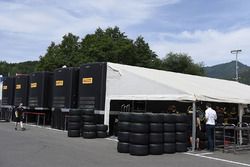FIA acts on tyre pressure concerns with new checks
Formula 1's system for checking tyre pressures has been changed ahead of the Austrian Grand Prix, in a bid to prevent teams using tricks to get around current limits.

Photo by: Pirelli



Following months of speculation that some outfits had found ways to manipulate pressures once tyres were fitted to the cars, the FIA has acted.
In a note sent to teams on Friday morning, F1 race director Charlie Whiting confirmed that from now on tyre pressures would be checked before wheels were fitted to cars.
This is aimed at preventing teams from potentially raising the pressures through heat when the tyres are first fitted to the car - and then cooling them down to bring the pressures down to a level that will deliver better performance.
It is understood that one of the motives for imposing such a new system was also that if the tyre pressure situation becomes more stable, then Pirelli may agree to lower the limits they have been putting in place.
Pirelli has hinted several times that the current limits are being set so high because they have to factor in that some outfits are bringing the levels down.
Investigation over
Since the Monaco Grand Prix, the FIA has been closely monitoring the tyre pressures of all teams to try to get a better understanding of what they are up to.
The results of that investigation are understood to have prompted the governing body to introduce the new procedures.
Pirelli motorsport director Paul Hembery told Motorsport.com recently that his company was eager for action to be taken to avoid the possibility to teams being able to manipulate the pressures after checks had taken place.
"We have found a few areas that we feel are a little bit grey from our point of view," he said.
"This is a key area for the tyre maker. You need to understand what pressures are being operated in real circumstances, and we need to address it this year.
"This will also stop people investing a lot of money they don't have in trying to find ways to optimise the situation. That is not what we want people spending money on."
No releasing air
In the note, a copy of which has been seen by Motorsport.com, Whiting said that both new and used tyres would be checked before being fitted to the cars in practice and qualifying.
Ahead of the race, tyres would be also be checked on the grid before they were fitted to the cars.
Teams will have to ensure that the pressures are above the minimum limits laid down by Pirelli – but will be able to make adjustments if their tyres are well above the mandatory levels.
However, Whiting has made it clear that teams will not be allowed to release air from the tyres after the checks have taken place.
“Once set no air may be released from the tyres but air may be added," he said. "In addition, if a set of tyres is used more than once in any session there will be no requirement to reset the pressures to the minimum starting pressure."
Be part of Motorsport community
Join the conversationShare Or Save This Story
Subscribe and access Motorsport.com with your ad-blocker.
From Formula 1 to MotoGP we report straight from the paddock because we love our sport, just like you. In order to keep delivering our expert journalism, our website uses advertising. Still, we want to give you the opportunity to enjoy an ad-free and tracker-free website and to continue using your adblocker.















Top Comments